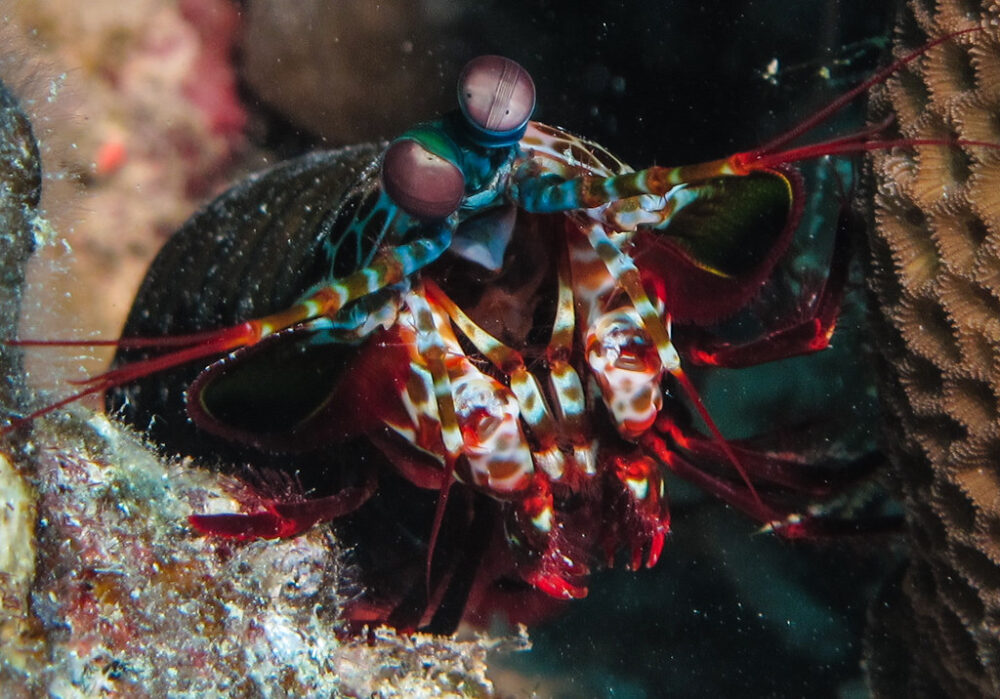Light tends to come with life, and with darkness, death. This theme extends throughout the animal kingdom, but what if there was a way to see light in the darkness? Just ask the mantis shrimp, a 340-million-year-old carnivorous marine crustacean with an amazing gift. This little critter has perhaps the best vision in the history of life on this planet. The mantis shrimp’s eyes contain 12 photoreceptors, compared to 3 in human eyes. The main properties of light are color, intensity, and polarization. Mantis shrimp can perceive each property in-depth and are able to detect the slightest change in their environment.
Light is a very complex phenomenon. It travels through space as a transverse wave, meaning it is S-shaped and vibrates vertically, horizontally, or at any angle in between. Generally, light waves are evenly distributed across all angles, which scatter once they reflect off of an object. A particular kind of light is polarized light, which has its wave oscillation limited to one plane that moves along the same angle in space, allowing it to reflect off of a large surface in the same direction. An example of this is a laser pointer. Mantis shrimp use this reflective property to their advantage. By using the mid-band of their 12 photoreceptors, they can filter polarized light and can view the angle at which the light is reflected (sometimes up to about 10 to 20 degrees), thus allowing them to pinpoint an object or animal in space. This helps them hunt, avoid predators, and even potentially mate. This adaptation allows them to sense properties of light invisible to other animals.
Human technology has drastically improved over the last 100 years, however, the mantis shrimp beat us to this amazing innovation by 340 million years.
Light can exhibit a phenomenon called circular polarization. This is when the light beam moves in the shape of a helix, meaning that the wave could rotate clockwise or counterclockwise. Mantis shrimp can physically reflect circularly polarized light off of their eyes, as a hidden method of communication, allowing them to signal others without alerting predators of their presence. Cuttlefish, squid, and octopus, which all prey on the mantis shrimp, are able to detect the same polarized light, but are oblivious to circularly polarized light. This provides the mantis shrimp with a safe method of signaling for mates and navigating through murky water.
The incredible adaptation that mantis shrimp possess has inspired the next generation of cameras that can closely imitate their impressive visual apparatus. The new camera was developed last year and can be manufactured in bulk for prices as cheap as 10 dollars per unit. Researchers from the University of Illinois at Urbana-Champaign believe it could help self-driving cars and military drones detect hidden objects and hazards. In a real-world test with the camera, the research team drove around in a car mounted with the shrimp-inspired camera and a standard camera. Images derived from the new camera displayed a much higher contrast of images taken in low-visibility conditions, such as rain and shadows, in comparison to the standard one. The details detected in the background of the images were unlike any sample ever taken before. Previously, most high-tech cameras were only able to distinguish the visible spectrum from infrared and ultraviolet light, which brought out some hidden details, but not nearly as much as the new innovation.
Who would have thought that such a tiny animal could potentially have such a large impact on human civilization?
This camera has roughly 500,000 sensors that view a wide variety of light and dark spots within the desired range, allowing it to detect polarized light wavelengths and interpret that information. The nanosensors inside of the device are meant to imitate the photoreceptors of the shrimp, converting the polarized light into pixels that the car can recognize. This camera is revolutionizing the self-driving technology of the future. In addition, these cameras can aid in healthcare by allowing doctors to differentiate cancerous cells from benign tumor cells and to see more clearly during surgeries.
Human technology has drastically improved over the last 100 years, however, the mantis shrimp beat us to this amazing innovation by 340 million years. Who would have thought that such a tiny animal could potentially have such a large impact on human civilization?
Current Biology (2012). DOI: 10.1016/j.cub.2012.01.010




